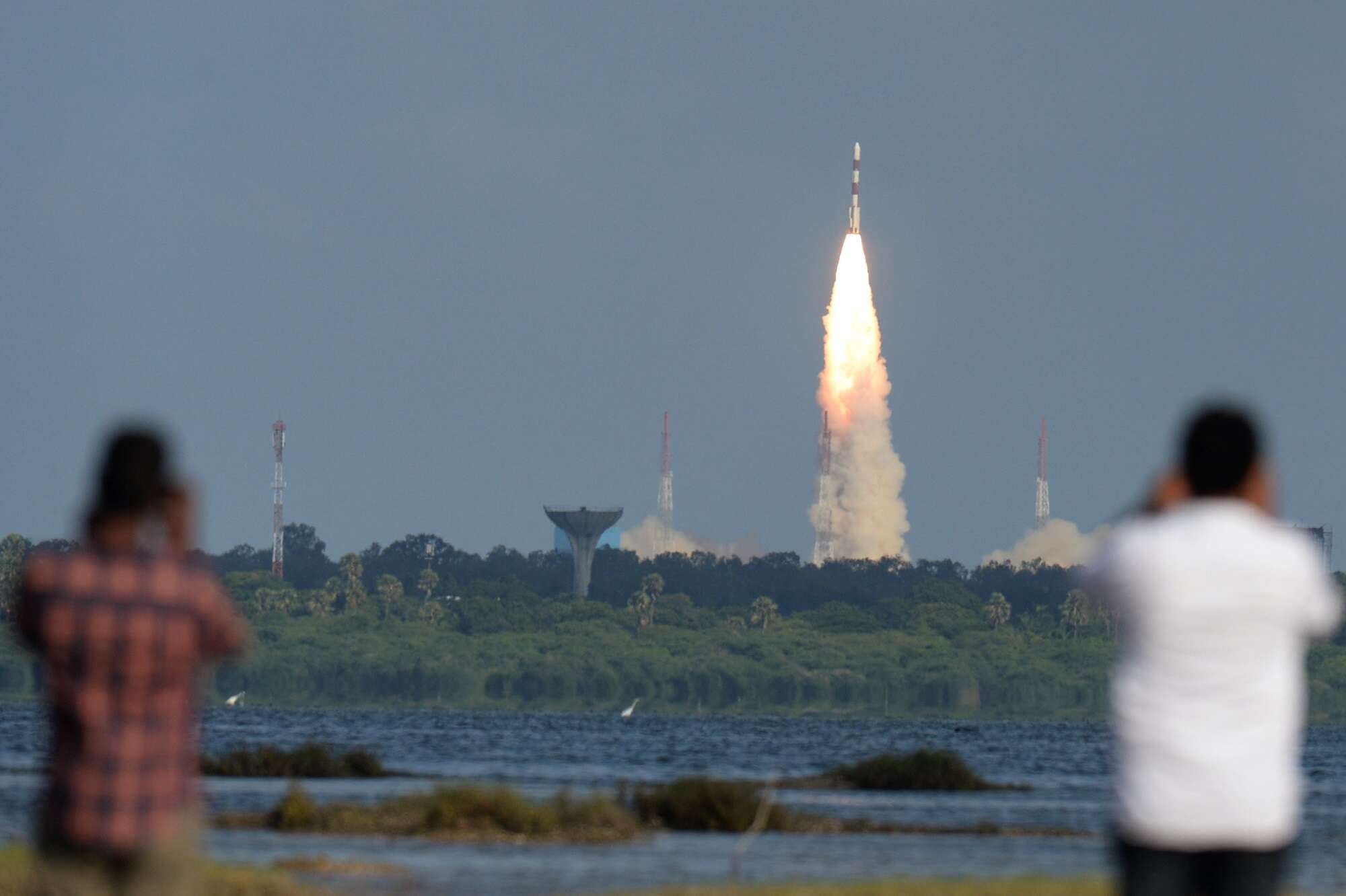
In mid-July, Australian Police warned curious locals to steer clear of the mysterious copper-hued cylinder that had washed up on a sandy beach north of Perth. A chemical analysis by the local fire department soon concluded that the ominous object didn’t pose a risk to the local community, but it took another week and a half of fevered speculation before its true origins became known. It came from outer space, the Australian Space Agency definitely did not intone in the voice of a 1950s B-movie narrator – specifically, from a spent Indian rocket that had failed to blaze brightly into a million petty fragments on its journey back to Earth.
What the world has not appreciated is that the rocket in question is the pride of India’s satellite industry. Launched 58 times from the country’s Satish Dhawan Space Centre with a success rate of 94%, the Polar Satellite Launch Vehicle is (usually) one of the world’s most reliable heavy-load rockets and the workhorse of an Indian space sector that has grown in stature and capability in recent years. That status has been hard won. Though Indian astronomers have been interested in charting the stars for millennia, the country’s attempts to actually reach them actually began in 1963, with the launch of a sounding rocket carried to the pad by a bullock cart. Since then, the Indian Space Research Organisation (ISRO) has developed full launch capabilities, deployed extra-terrestrial missions, and flung fleet after fleet of homegrown satellites into orbit.
Despite all these successes, however, India’s private space industry has – until very recently – struggled to get off the ground. Private participation in India’s space sector has long been stifled by strict government restrictions on satellite capabilities, but recent reforms, which were personally supported by Prime Minister Narendra Modi, have eliminated many of these regulatory hurdles. Estimates valued the global space-launch market at between $8bn and $14.5bn in 2022 – and India wants a slice of that sizable pie.
International investors, it seems, also want in on India’s emerging satellite-launch ecosystem. Consultancy firm Arthur D. Little has estimated that India’s space market could reach $100bn by 2040 – a figure that’s boosted by the nation’s growing satellite-launch capacities. “Deployment of a constellation of satellites in middle-earth orbits may emerge as a game changer for the Indian Space Business,” reads the report, which was published in July.
After a slow start, India is now home to at least 140 registered space start-ups, rising from just five at the beginning of 2020, according to the New York Times. Investors poured $119m into this ecosystem in 2022, according to Reuters. Geopolitical tensions might also be working in India’s favour. With Russia and China off the table for many Western firms, India looks set to emerge as the world’s new favourite cut-price destination for satellite launches. British satellite broadband company OneWeb, for example, launched 36 LEO satellites from India in March after the outbreak of Russia’s brutal war in Ukraine put a stop to its scheduled launches onboard Moscow’s famed Soyuz Rocket.

India’s space odyssey
The stars started to align for India’s private space sector in October 2020, when the country’s Department of Space released a draft of its New Spacecom Policy. This policy – which was finally fully unleashed, after some additional modifications, earlier this year – aimed to open India’s satellite-launch sector to private businesses. “It got everybody excited,” says Krati Hashwani, a specialist telecommunications lawyer at the law firm Trilegal in Bangalore. Even before the official enactment of the draft policy, Trilegal’s international clients already started working towards building business in India, while domestic players in the field accelerated their bids to cut the hefty costs of satellite launches.
The new policy replaced the Satcom Policy of 1997, a restrictive set of regulations that limited private and foreign participation in the sector and didn’t envisage the immense rate of technological development, explains Hashwani. The dawn of LEO (low-earth orbit) satellites, which are much smaller and cheaper than traditional geostationary satellites, has been an industry game changer, opening the doors for the rise of satellite broadband — a market that India’s particularly keen to capitalise on.
In June 2022, amid the widespread overhaul of India’s space ecosystem, Dhruva Space and Digantara Aerospace were announced as the first two private companies to receive authorisation from regulatory authority IN-SPACe to conduct space-related activities. In the case of Dhruva Space, this allowed the firm to test its homemade satellite deployers on ISRO’s PSLV in June 2022 and to launch its first CubeSats into low-earth orbit (LEO) in November 2022.
Timing has also been crucial to the unprecedented growth of India’s space ecosystem, explains Dhruva’s founder and CEO, Sanjay Nekkanti. Demand for telecommunications satellites is expected to balloon in the coming years – a fact Modi explicitly identified in his push to open up India’s space ecosystem. “The global supply chain needs to be robust and strong,” says Nekkanti. “Dhruva Space works actively in the ecosystem with 400-odd companies that have been building small yet important components for the Indian Space Programme for many decades now. By working with these vendors, Dhruva Space can deliver missions and send up missions faster, economically without impacting reliability.” With this in mind, Nekkanti continues, “India’s space industry is primed for a stellar trajectory.”

Satellite status
Vikram-S, India’s first privately-built rocket, lifted off from Satish Dhawan Space Centre on 18 November 2022. It was developed by Skyroot Aerospace, a start-up founded in 2018 by former engineers and scientists from ISRO. The company, which is based in Hyderabad, has raised a total of $68.1m, according to Crunchbase. They’re hoping that Vikram-S will pave the way for Skyroot’s future rockets, which are projected to carry far heavier – and more profitable – payloads into space. Founders Pawan Chandana and Bharath Daka told Reuters they’re hoping to launch their first satellite into orbit in 2023 at just half of the cost of more-established launch companies.
There’s also Chennai-based Agnikul Cosmos, which has promised to cut costs for satellite launches. The start-up, which has raised $34.5m, plans to develop a small-scale rocket, called the Agnibaan, that’ll be capable of placing a 100kg satellite into a 700km orbit. Progress has been slow: the first launch was previously projected for 2022, but none have come to fruition. Nevertheless, co-founder Srinath Ravichandran told Bloomberg he’s still confident that Agnikul can achieve its new goal of completing four launches in 2024 by taking advantage of India’s newfound embrace of space start-ups.
It may have taken a while for India’s private space industry to get off the ground “but it’s only uphill from here”, says Hashwani. “We’ve already overcome the biggest hurdle, which was for the [New Satcom Policy] to see the light of the day.”
Nevertheless, India’s newly unleashed ecosystem still has hard work ahead of it. Launching satellites is a notoriously tricky and capital-intensive endeavour, and India’s capabilities are still trailing far behind the likes of China’s. There might be lots of near-term opportunities, but any unforeseen delays can, given the rapid rate of technical developments, be immensely costly – causing India’s emerging launch providers to lose out to nimbler competitors.






